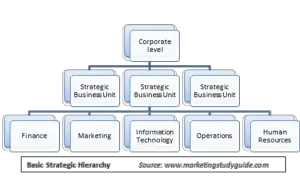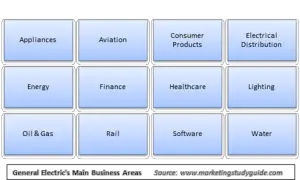To help understand how the strategic hierarchy model helps us understand how the concept of strategy differs between levels in an organization, let’s look at one of the world’s largest and most diversified companies, General Electric (GE).
The following model shows the generic strategic hierarchy model often found in marketing strategy textbooks.
The diagram below shows the main industries in which General Electric chooses to operate. There are 12 main areas listed. Within most of the areas listed they operate individual businesses (what we are calling strategic business units or SBUs). Those strategic business units have their own management teams and functional areas (of marketing, finance, human resources, and so on).
Therefore, think about the complexity of this business structure when reviewing the next section on what types of strategic decisions are made at different management levels.
Understanding the Strategic Hierarchy
As suggested above, when you look at the enormous scope of the operations of an organization like General Electric (GE), it becomes easier to see that the different management levels will need to concentrate on different areas of the business. The table below provides a list of the types of decisions that would be made at the corporate, SBU and functional management levels.
At each of these levels, the word ‘strategy’ clearly takes on a different meaning. At the corporate level, strategy is based around making major decisions regarding their business portfolio (that is, mix of SBUs or individual businesses) – and what to buy, sell, expand, reduce, and so on.
Competitive strategy considerations are the prime focus at the SBU level – how should we compete? It is at this level that marketing strategy is primarily developed and/or approved. This level represents the senior management team of a firm.
Finally, the function level is most concerned with actual implementation and bringing the strategy to life. So their strategic decisions would be things like: how much to invest in advertising, what new products need to come market next year, do we need to change our pricing structure, and so on.


